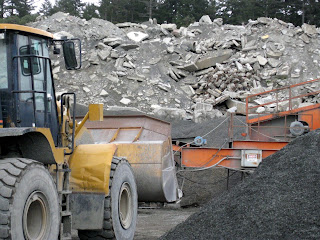It is time to sort through the construction waste materials.
Josh took all larger pieces of plywood to use on his next job site. It is useful for making the form work. He didn't have to buy much more plywood for the form work because he reused a lot from the construction of the Green Shed.
All of the smaller pieces of plywood and all painted wood was piled up to be taken away in the garbage trailer. It is all the wood with glues and chemicals that are not safe to burn.
The garbage trailer also took away plastics used to wrap supplies, hold glue and cover curing cement.
I presume it will go to the local landfill where the trailer will be weighted and we will be charged according to that weight.
The left over blasted rock in the background will be used to edge paths.
I used some of the broken pavers as stepping stones in some of the garden beds but most of them, along with the waste concrete, was stacked under the Green Shed's Contemplation Room, there if we ever need it. Because of its weight, it would have cost a lot of money to dispose of in the landfill and there wasn't enough to warrant a dump truck taking it all the way to the quarry for recycling.
Taylor tackled the remaining waste wood pile. He and Josh had reused it so many times on the job the remaining pieces were just smallish off cuts.
I measured the sizes of our 2 fireplaces to find out the maximum length of wood each to take. Taylor then used these 2 numbers to make the best cuts in the remaining wood. Here he is making 2 stacks with longer pieces on the right and shorter pieces on the left.
It was pointed out to me we would be paying for Taylor's time to cut this wood. I pointed out how much it costs to have a pickup truck load of firewood delivered. Also, I was not comfortable with paying for this wood to go into a landfill when we could use it.
Josh used the forks attachment on the Bobcat to move the bundle of long pieces up to the patio area and put it as close as he could to where it was needed.
Ron then moved each piece and re stacked it beside the chimney. Notice the air holes he has left to help keep the wood dry.
The last couple of trees that fell during the winter storms have been cut up, some of it in suitable lengths for firewood. This called 'hucking' the log. These lengths are left to dry out for a bit or not (there are different schools of thought on this) then Ron splits them. He dumps them behind the propagation table and it is my job to crawl under and stack the wood. It will be protected behind the glass and the bottom part will allow air to circulate.
Locating the firewood stack here is another function of the Propagation Room and it solves the previous problem of there being nowhere to stack firewood near where it was needed. The fireplace is inside the house to the left.
Plus I love the look of stacked firewood as a design feature and for other reasons.
When a tree falls or needs to be cut down for safety reasons we now have a standard order for cutting it up. If it is still standing we ask to leave about 15 to 20 feet standing and hope it will become a wildlife tree. The tree above fell over and its root area will be left as is because the disturbed soil stimulates all sorts of soil organism and plant activity.
Next the widest part of the trunk is hucked into lengths to later be split for firewood. The next section of about 15 feet is left lying on the ground as a nurse log to support new growth in the forest. The next part is cut into 5 inch rounds and I use these for making 'gardener's paths' to give access into the middle of the wider garden beds. Depending on the length of the tree there may be another section for firewood. The last part of the trunk I use the small sections as edges for garden beds. The branches are cut off and left insitu to protect young plants in the undergrowth eventually rotting down to feed the soil.
When I explain what I want to the most obliging forester it reminds me of giving the butcher the order when cutting up a whole animal.
Ron is stacking the shorter lengths of construction waste firewood under the inside of the propagation table. I didn't want to be able to see it from the outside thinking it would not look very attractive but he has done such a neat job I think it looks lovely.
So that is the story about managing the waste materials from the Backyard Project construction site.


























































